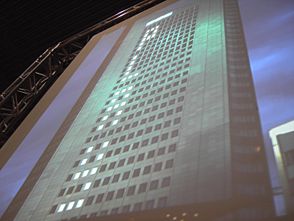High Rise Leipzig City
| project overview | |

| |
| Year | 2007 |
| Number of pixels | 300 (12x25) |
| Grayscales / Colors | 8 Grayscales |
| Illuminant | only PC simulation |
| Power input | |
| Contact person | Stephan 'ST' Kambor, Stefan Schürmans |
| Project website | |
The Project High Rise Leipzig City was developed for its one-shot (so far) at the Games Convention 2007. It is a simulation of the Leipziger City-Hochhaus (Wikipedia Germany) and enables people to use the front of the building as a huge screen which was projected onto a wall. Visitors were not only invited to watch greyscaled movies but also to play simple games as Pong and Tetris with their own mobile phones. The High Rise Leipzig City was part of the "public play" exhibition created and built up by the Berlin Museum of computer games as a successor of the pong.mythos exhibition from the year before. The simulator will remain a part of "public play" in case of turning the show into a travelling exhibition, because it can be adapted to any other building as well. Hopefully, the simulator gets a lot of possibilities for public appearance.
One can get through to the simulated High Rise Leipzig City by calling a determined number, when the computer is connected with an ISDN line. The game Pong from the top to the bottom (vertical) is started automatically. The paddle can be moved by pressing the buttons 4 and 6. If there is another caller while one person is playing, they play against each other. Otherwise, the person plays against the computer. By pressing *1# Pong from the right to the left (horizontal) begins and the paddles are controlled with buttons 5 and 8 then (2 and 8 are also possible). The winner is the player who collected 10 points first. A new round can be started by pressing *0# (vertical) or *1# (horizontal) again.
The combination *2# starts Tetris. People should be familiar with intention and rules of the game. The current block moves to the left or to the right by using the buttons 4 and 6, rotates by pressing 5 and falls down by pushing 8. A new round of this game can also be started with the key combination from the beginning. The game ends, when the player hangs up.
The computer is an ordinary one with 2GHz Dual Core Prozessor, ISDN, on-board graphics card and 512 MB Ram -- nothing to write home about -- and the operating system is Debian 4.0 (Etch). Re software it is made use of modified versions of blccc (Blinkenlights Chaos Control Center), blib (Blinkenlights Library), blinkisdn, blinkensim and blinkenthemes with different new functions and bugfixes. Stefan published the software on his website, as it is all GPL software, of course:
http://stefan.blinkenarea.org/blinkenlights/